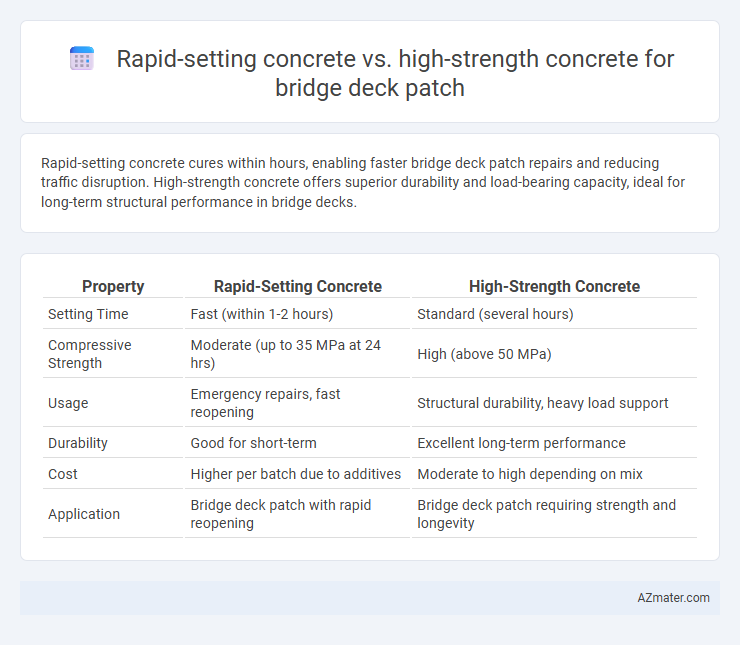Rapid-setting concrete cures within hours, enabling faster bridge deck patch repairs and reducing traffic disruption. High-strength concrete offers superior durability and load-bearing capacity, ideal for long-term structural performance in bridge decks.
Table of Comparison
| Property | Rapid-Setting Concrete | High-Strength Concrete |
|---|---|---|
| Setting Time | Fast (within 1-2 hours) | Standard (several hours) |
| Compressive Strength | Moderate (up to 35 MPa at 24 hrs) | High (above 50 MPa) |
| Usage | Emergency repairs, fast reopening | Structural durability, heavy load support |
| Durability | Good for short-term | Excellent long-term performance |
| Cost | Higher per batch due to additives | Moderate to high depending on mix |
| Application | Bridge deck patch with rapid reopening | Bridge deck patch requiring strength and longevity |
Introduction to Bridge Deck Repair Materials
Rapid-setting concrete offers fast curing times ideal for minimizing traffic disruption during bridge deck repairs, providing sufficient early strength for load-bearing applications. High-strength concrete delivers superior long-term durability and load capacity, essential for heavy-traffic bridge decks requiring extended service life. Selecting between these materials depends on project timelines, structural requirements, and environmental exposure conditions to optimize bridge deck restoration.
Overview of Rapid-Setting Concrete
Rapid-setting concrete offers accelerated curing times typically within 1 to 4 hours, enabling quick reopening of bridge decks to traffic and minimizing downtime. It achieves early strength gain through specialized cementitious materials and chemical admixtures, making it suitable for emergency repairs and cold-weather conditions. Compared to high-strength concrete, rapid-setting concrete prioritizes fast strength development rather than maximum long-term compressive strength, often reaching 3,000 to 5,000 psi within hours.
Overview of High-Strength Concrete
High-strength concrete used in bridge deck patching typically features compressive strengths above 6,000 psi, providing enhanced durability and load-bearing capacity essential for infrastructure longevity. Its low permeability and improved chemical resistance protect against environmental factors such as chloride penetration and freeze-thaw cycles, reducing maintenance frequency and extending service life. The mix design often includes supplementary cementitious materials like silica fume, which contribute to increased mechanical performance and shrinkage control compared to conventional concrete.
Key Performance Differences
Rapid-setting concrete offers accelerated curing times, enabling bridge deck patches to reopen to traffic within hours, significantly reducing downtime. High-strength concrete provides superior compressive strength exceeding 6000 psi, ensuring long-term durability and load-bearing capacity under heavy traffic conditions. The choice hinges on balancing immediate usability with structural longevity, where rapid-setting suits urgent repairs and high-strength supports permanent restoration.
Setting Time and Traffic Reopening
Rapid-setting concrete typically achieves initial set within 30 to 60 minutes, enabling traffic reopening in as little as 2 to 4 hours, which is essential for minimizing bridge deck closure times. In contrast, high-strength concrete generally requires 24 to 48 hours to reach sufficient strength for traffic, despite offering superior load-bearing capacity and durability long-term. Choosing rapid-setting concrete accelerates bridge deck patch repairs and reduces traffic disruption, while high-strength concrete suits applications where extended curing time is acceptable for enhanced structural performance.
Strength Requirements for Bridge Deck Patches
Rapid-setting concrete achieves early strength gain, often reaching 3,000 psi within hours, making it ideal for emergency bridge deck repairs requiring quick load return. High-strength concrete typically attains compressive strengths above 6,000 psi, providing long-term durability and resistance to heavy traffic and environmental stresses on bridge decks. Selecting between rapid-setting and high-strength concrete depends on balancing immediate strength requirements with the desired lifespan and performance of the bridge deck patch.
Durability Considerations in Bridge Applications
Rapid-setting concrete offers accelerated curing times essential for minimizing traffic disruption during bridge deck repairs, but may exhibit lower long-term durability under aggressive environmental conditions compared to high-strength concrete. High-strength concrete provides enhanced resistance to freeze-thaw cycles, chloride ion penetration, and mechanical wear, ensuring prolonged structural integrity in critical bridge applications. Selecting the appropriate mix depends on balancing the need for quick return to service with the expected exposure to durability challenges such as deicing salts and heavy traffic loads.
Cost Implications and Material Availability
Rapid-setting concrete offers lower labor and downtime costs due to its fast curing time, making it ideal for urgent bridge deck patches, but often comes at a higher material price compared to conventional mixes. High-strength concrete, characterized by compressive strengths above 6,000 psi, provides long-term durability and resistance to heavy traffic loads, though the specialized materials required may limit availability and increase procurement costs. Balancing cost implications and material availability depends on project timing, load requirements, and regional supply chains.
Application Methods and Workability
Rapid-setting concrete for bridge deck patch offers significantly faster curing times, enabling quicker traffic restoration and minimizing downtime in critical infrastructure areas. Its application methods typically involve mixing on-site with specialized additives that accelerate hydration, requiring precise timing and immediate placement to ensure optimal bonding and strength. High-strength concrete, in contrast, provides superior load-bearing capacity and durability but demands longer curing periods and more controlled application environments to achieve proper workability and minimize shrinkage or cracking during the repair process.
Best Use Cases: Selecting the Right Concrete for Bridge Deck Patching
Rapid-setting concrete is ideal for emergency bridge deck patching where fast curing and early strength gain are critical to minimize traffic disruption, making it suitable for temporary repairs or fast-track projects. High-strength concrete, characterized by compressive strengths above 6,000 psi, is preferred for permanent patching on heavily loaded bridge decks, providing long-term durability and resistance to freeze-thaw cycles and deicing chemicals. Selecting the right concrete depends on balancing the urgency of repair, load demands, environmental exposure, and desired longevity of the patch.

Infographic: Rapid-setting concrete vs High-strength concrete for Bridge deck patch
 azmater.com
azmater.com